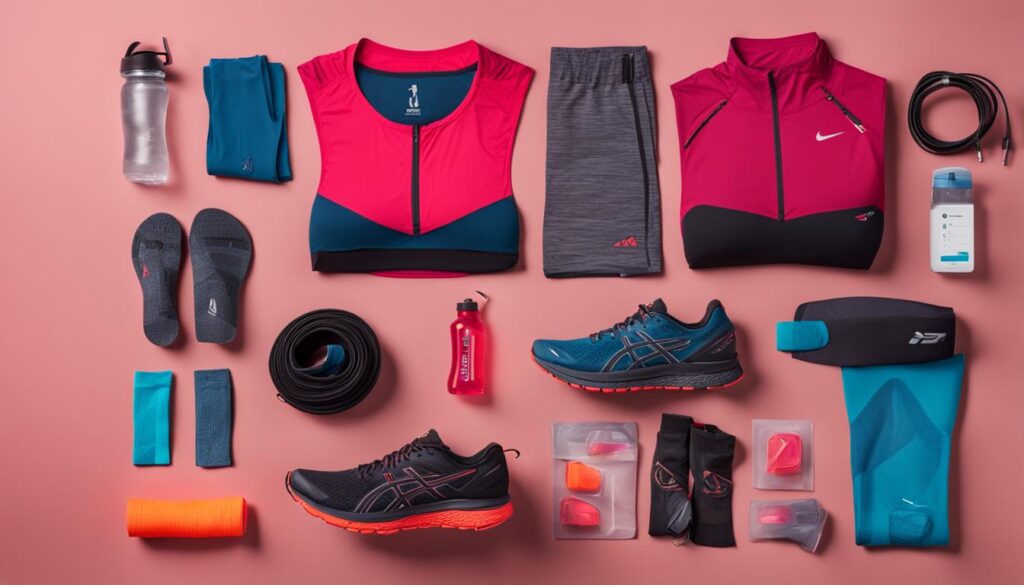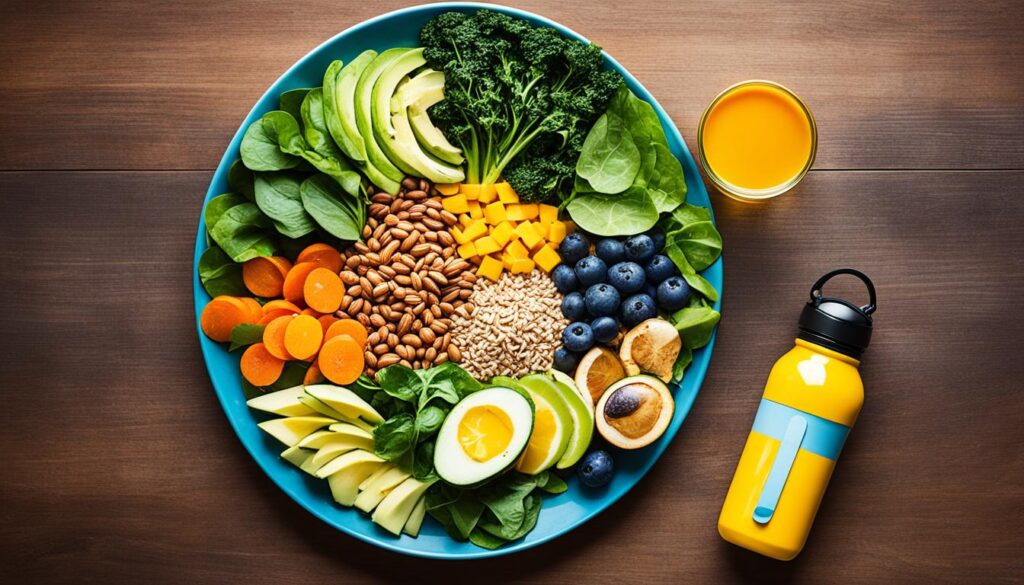Running has long been recognized as an effective exercise for weight loss. Not only does it burn calories, but it also strengthens your cardiovascular system and improves overall fitness. However, it’s important to approach running for weight loss in a sustainable way to achieve long-term success. In this beginner’s guide, I’ll provide you with valuable tips and information to help you reach your weight loss goals through running.
Key Takeaways:
- Running is a popular activity for weight loss due to its ability to burn calories and improve cardiovascular health.
- Approaching running for weight loss in a sustainable way is crucial for long-term success.
- In this beginner’s guide, I’ll share valuable tips to help you start your running journey and achieve sustainable weight loss.
- By starting slowly, choosing the right running gear, incorporating strength training, and monitoring your progress, you can maximize the benefits of running for weight loss.
- Remember to prioritize proper nutrition and listen to your body to avoid injuries and support your weight loss goals.
The Importance of Starting Slowly
When it comes to starting a running routine for weight loss, it’s essential to prioritize gradual progress. Rushing into intense workouts can lead to injuries and discourage beginners from sticking to their plan. By taking things slow, you give your body the time it needs to adapt and avoid unnecessary strains.
As a beginner, building confidence is key. Start by incorporating short jogging intervals into your walks. Alternate between walking and jogging for a few minutes at a time, gradually increasing the jogging intervals as you feel more comfortable. This allows your body to adjust to the demands of running without overwhelming it.
“It’s important to remember that everyone’s journey is different. What works for one person may not work for another. Starting slowly ensures that you’re building a solid foundation and setting yourself up for long-term success.” – Emily Johnson, experienced runner
Developing a Sustainable Running Routine
As you progress in your running journey, it’s crucial to develop a sustainable routine that fits your lifestyle and goals. Here are some tips to help you along the way:
- Set realistic goals: Start with small, achievable goals and gradually increase your targets. Celebrate each milestone to stay motivated.
- Listen to your body: Pay attention to any signs of pain or discomfort. Take rest days when needed and don’t push yourself too hard too soon.
- Warm up and cool down: Prioritize a proper warm-up and cool-down routine to prevent injuries and improve overall performance.
- Incorporate strength training: Strength training helps build a strong foundation and supports your running form. Include exercises that target your legs, core, and upper body.
- Stay consistent: Consistency is key when it comes to running. Aim for a regular schedule that works for you, whether it’s early morning runs or afternoon sessions.
Remember, starting a running routine is a journey, and progress takes time. Focus on building a routine that is sustainable and enjoyable for you. By taking the necessary steps to start slowly and gradually progress, you’ll set yourself up for long-term success in your weight loss journey.

| Benefits of Starting Slowly | Tips for Starting Slowly |
|---|---|
| Reduces the risk of injuries | Alternate between walking and jogging |
| Allows your body to adapt gradually | Begin with short jogging intervals |
| Builds confidence in your running abilities | Increase jogging intervals as you feel comfortable |
| Ensures long-term sustainability | Listen to your body and take rest days when needed |
Essential Tips for Beginner Runners
As a beginner runner, there are several important tips to keep in mind for successful weight loss. Implementing these tips will not only help you shed those extra pounds but also improve your overall health and well-being. From optimizing your running time to preventing boredom, here are some essential tips to help you stay motivated and enjoy your running journey.
1. Optimal Running Time
Choosing the right time to run can make a significant difference in your weight loss journey. Morning runs are a great way to kickstart your metabolism and energize your body for the day ahead. However, if mornings aren’t your thing, don’t worry! Find a time that works best for you, whether it’s during your lunch break or in the evening. Consistency is key, so aim for at least three to four running workouts per week.
2. Preventing Boredom
Running can become monotonous if you do the same route or workout over and over again. To keep things interesting and prevent boredom, vary your running routes, explore different trails or parks, or try interval training. Interval training involves alternating between periods of high-intensity running and recovery periods of walking or jogging. This not only adds variety to your workouts but also helps burn more calories and build endurance.
3. The Importance of Stretching
Don’t underestimate the power of stretching! Before and after every run, take a few minutes to stretch your muscles. This helps improve flexibility, reduces the risk of injuries, and enhances your overall running performance. Focus on key areas such as your calves, hamstrings, quadriceps, and hip flexors. Incorporating dynamic warm-up exercises, such as leg swings and high knees, can also prepare your body for a successful run.
4. Benefits of Running for Health
Aside from weight loss, running offers numerous health benefits. Regular running workouts can improve cardiovascular health, strengthen your immune system, boost mood, and reduce the risk of chronic diseases such as heart disease and diabetes. Additionally, running outdoors exposes you to fresh air and nature, which can have positive effects on mental health and well-being.
5. Stay Motivated
Stay motivated and committed to your weight loss goals by setting achievable targets. Track your progress, celebrate milestones, and reward yourself for achieving small victories along the way. Joining a running group or finding a running buddy can also provide encouragement and accountability. Remember, running is not just a means to an end but a lifelong journey towards health and fitness.
| Tip | Benefits |
|---|---|
| Optimal Running Time | – Kickstart metabolism – Energize body – Consistency in routine |
| Preventing Boredom | – Varied routes and trails – Interval training for calorie burn – Improved endurance |
| The Importance of Stretching | – Improve flexibility – Reduce injury risk – Enhance running performance |
| Benefits of Running for Health | – Cardiovascular health – Stronger immune system – Positive effects on mental well-being |
| Stay Motivated | – Set achievable targets – Track progress – Join a running group or find a buddy |
Keep these essential tips in mind as you embark on your running journey. With dedication, consistency, and the right approach, running workouts for weight loss will not only help you achieve your goals but also enhance your overall health and well-being.
Choosing the Right Running Gear
When it comes to running, having the right gear is crucial for a comfortable and enjoyable experience. As a beginner, selecting the appropriate running gear can make a significant difference in your performance and overall running journey.
The Importance of Proper Running Shoes
One of the most important pieces of running gear for beginners is a pair of well-fitting running shoes. Investing in a quality pair designed for running can help prevent discomfort, blisters, and injuries. Look for shoes with proper cushioning and support, tailored to your unique foot shape and running style. Visit a specialty running store to get a professional fitting and expert advice on the best shoes for you.
“Having the right pair of running shoes can make all the difference in your comfort and performance while running.”

The Benefits of a High-Impact Sports Bra
For female runners, a high-impact sports bra is a game-changer. It provides secure support and minimizes breast movement during running, reducing discomfort and potential long-term damage to breast ligaments. Look for sports bras specifically designed for high-impact activities, with features such as adjustable straps, moisture-wicking fabric, and underwire or compression support.
“Investing in a high-impact sports bra can enhance your comfort and confidence during runs, ensuring a more enjoyable experience.”
By choosing the right running gear, including proper shoes and a high-impact sports bra, you can improve your running performance, prevent injuries, and enhance your overall running experience. Whether you’re just starting your running journey or looking to upgrade your gear, make sure to prioritize comfort, support, and functionality.
Running Outdoors vs. Treadmill Running
When it comes to running for weight loss, the choice between running outdoors or running on a treadmill is a common dilemma. Each option offers unique benefits and considerations that can impact your running experience. Let’s explore the advantages and disadvantages of both to help you make an informed decision.
Running Outdoors
Running outdoors provides a refreshing change of scenery and allows you to connect with nature. The fresh air and natural surroundings can invigorate your senses and make your runs more enjoyable. Whether you prefer the tranquility of a park or the excitement of urban streets, outdoor running offers a variety of environments to suit your preferences.
Engaging with the natural elements also adds an extra challenge to your workout. Uneven terrain and varying weather conditions require more effort from your muscles and can help improve your balance and agility over time. Additionally, running outdoors exposes you to vitamin D from sunlight, which is essential for bone health and overall well-being.
“Running outdoors allows me to experience the beauty of nature and feel a sense of freedom. It’s invigorating and helps me clear my mind.” – Emily, avid runner
Treadmill Running
Running on a treadmill provides convenience and control over your running conditions. With a treadmill, you can adjust the speed, incline, and even monitor your heart rate during your workout. This level of customization allows you to tailor your runs to match your fitness level and specific training goals.
One advantage of treadmill running is the consistent surface it provides. The cushioned belt reduces the impact on your joints, making it a suitable option for those with knee or joint issues. Additionally, the controlled environment of a gym or home setting allows you to run regardless of the weather conditions, ensuring you never miss a workout.
“Running on a treadmill gives me the precision I need for interval training. I can push myself harder and monitor my progress more effectively.” – Alex, fitness enthusiast
Choosing the Right Option for You
The decision between running outdoors and running on a treadmill ultimately depends on your personal preferences and lifestyle. To help you make an informed choice, consider the following factors:
- Flexibility: Running outdoors offers the freedom to explore new routes and locations, while a treadmill provides the convenience of running at any time, regardless of the weather.
- Mental Stimulation: If you enjoy being immersed in nature and find inspiration from changing scenery, outdoor running may be more appealing. However, if you prefer a focused and controlled environment, a treadmill may better suit your needs.
- Training Goals: Consider your specific fitness goals. If you’re training for a race that will take place outdoors, running on varied terrain can help prepare your body. On the other hand, if you’re preparing for a controlled event like a virtual race, training on a treadmill can provide the necessary consistency.
Remember, there’s no right or wrong choice when it comes to running outdoors or on a treadmill. You can also alternate between the two to add variety to your workouts and keep your running routine enjoyable.
| Running Outdoors | Treadmill Running | |
|---|---|---|
| Advantages |
|
|
| Disadvantages |
|
|
Consider your preferences, goals, and the current circumstances to choose the running option that motivates and suits you best. Whether you decide to hit the trails or lace up on a treadmill, remember that consistency and enjoyment are key to a successful weight loss journey through running.

The Role of Nutrition in Weight Loss
Alongside running, nutrition plays a crucial role in weight loss. It is important to fuel your body properly before and after runs to support your running routine and achieve sustainable weight loss.
Fueling Before the Run
Avoiding running on an empty stomach is essential to maintain energy levels and enhance performance. Prioritize consuming a balanced meal or snack containing carbohydrates, protein, and healthy fats about 1-2 hours before your run. This will provide the necessary fuel for your body to perform optimally.
| Pre-run Nutrition Tips |
|---|
| 1. Include complex carbohydrates such as whole grains, fruits, and vegetables for sustained energy. |
| 2. Opt for a moderate amount of easily digestible protein like lean meats, tofu, or Greek yogurt for muscle repair and growth. |
| 3. Add a small amount of healthy fats from sources like avocados, nuts, or olive oil to support overall health and satiety. |
| 4. Stay hydrated by drinking water before your run to prevent dehydration and promote proper digestion. |
Recovering with Post-Run Nutrition
Eating after running is just as important as fueling before the run. Proper post-run nutrition aids muscle recovery, replenishes glycogen stores, and supports overall weight loss efforts.
It is recommended to consume a combination of carbohydrates and protein within 30-60 minutes after your run. This timing allows for optimal nutrient absorption and muscle repair.
| Post-run Nutrition Tips |
|---|
| 1. Include easily digestible carbohydrates like fruits, whole grains, or a sports drink to replenish glycogen stores. |
| 2. Consume a moderate amount of lean protein sources such as chicken, fish, eggs, or plant-based alternatives for muscle repair. |
| 3. Incorporate antioxidant-rich foods like berries, leafy greens, or nuts to support recovery and reduce inflammation. |
| 4. Don’t forget to hydrate by drinking water to replace fluids lost during the run. |
By prioritizing nutritious meals and snacks before and after your runs, you will provide your body with the necessary fuel and nutrients for optimal running performance and weight loss.

Incorporating Strength Training
Adding strength training to your running routine can greatly benefit your weight loss journey. Incorporating exercises that target key muscle groups not only increases muscle strength but also improves your running efficiency.
Strength training for runners offers several advantages. It helps prevent injuries by strengthening muscles and stabilizing joints, allowing for better running mechanics and reducing the risk of imbalances. Additionally, building muscle through strength training can boost your metabolism, aiding in weight loss and body composition goals.
Benefits of Strength Training for Runners
When you combine strength training with your running routine, you can experience a range of benefits, including:
- Increased muscle strength and endurance
- Improved running form and efficiency
- Enhanced power and speed
- Better overall body balance and coordination
- Reduced risk of common running injuries
- Greater calorie burn and weight loss
By incorporating strength training exercises into your routine, you can optimize your performance as a runner and achieve your weight loss goals more effectively.
Key Muscle Groups for Runners
Targeting specific muscle groups is essential for runners seeking to improve their strength and performance. Here are some exercises that focus on key muscles:
| Muscle Group | Exercises |
|---|---|
| Quadriceps | Lunges, squats, step-ups |
| Hamstrings | Deadlifts, hamstring curls |
| Calf Muscles | Calf raises, box jumps |
| Glutes | Glute bridges, hip thrusts |
| Core | Planks, Russian twists, medicine ball twists |
| Upper Body | Push-ups, pull-ups, dumbbell rows |
Remember to choose weights or resistance levels that challenge you without compromising your form. It’s essential to maintain proper technique to reap the full benefits of strength training.
Incorporating strength training into your running routine can have a significant impact on your overall fitness and weight loss goals. By targeting key muscle groups and following a well-rounded strength training program, you can enhance your running performance, reduce the risk of injuries, and achieve optimal results.
Tracking Progress and Setting Goals
Monitoring your progress and setting goals is essential for staying motivated and tracking your weight loss journey. Monitoring weight loss progress allows you to see your achievements and identify areas for improvement. Setting running goals gives you something to work towards and helps you stay focused and committed.
To track your progress, consider using running apps or fitness trackers. These tools allow you to monitor key metrics such as distance, pace, and calories burned. They also provide valuable insights into your performance over time.
When setting goals, it’s important to make them specific, measurable, attainable, relevant, and time-bound (SMART). For example, instead of saying “I want to lose weight,” you could set a goal to “run 3 miles, three times a week, for the next 3 months.”
Remember, it’s important to set achievable goals that align with your current fitness level and consider any limitations or challenges you may have. Start with smaller short-term goals and gradually work towards larger long-term goals.
Tracking progress and setting new targets helps keep you motivated and engaged in your weight loss journey. It allows you to celebrate your successes and make adjustments when necessary. With consistent monitoring and goal setting, you’ll stay on track and continue to progress towards your running and weight loss goals.
Tracking Progress Example
| Date | Distance (miles) | Pace (min/mile) | Calories Burned |
|---|---|---|---|
| June 1 | 2.5 | 9:30 | 250 |
| June 8 | 3.0 | 9:15 | 275 |
| June 15 | 3.5 | 9:00 | 300 |
By tracking your running progress over time, you can see how you’ve improved in terms of distance, pace, and calories burned. This helps you set new goals that challenge you and push you further towards your weight loss objectives.
Dealing with Challenges and Injuries
Running is an exhilarating and beneficial exercise, but it can also come with challenges and the risk of injuries, particularly for beginners like you. However, with the right strategies and mindset, you can overcome these hurdles and stay on track towards achieving your weight loss goals. Here are some valuable tips to prevent running injuries and conquer common running challenges:
Preventing Running Injuries
1. Start Slow: Begin your running journey at a comfortable pace and gradually increase intensity and duration to allow your body to adapt.
2. Warm Up and Cool Down: Prioritize dynamic stretching before your runs to warm up your muscles and static stretching after to cool down and aid recovery.
3. Wear Proper Shoes: Invest in a pair of running shoes that provide adequate support and cushioning to reduce the risk of foot and leg injuries.
4. Incorporate Strength Training: Strengthening your muscles, especially the core and lower body, can help stabilize your joints and prevent overuse injuries.
5. Listen to Your Body: Pay attention to any signs of pain, discomfort, or fatigue. Rest or modify your training accordingly to avoid pushing yourself too hard.
6. Cross-Train: Engage in other forms of exercise like swimming or cycling to reduce the repetitive stress on your body from running.
Overcoming Running Challenges
“Running is not just about the physical activity; it is a mental and emotional journey of self-discovery and personal growth.”
– Me
1. Boredom and Lack of Motivation: Vary your running routes, listen to energizing playlists or podcasts, or partner up with a friend to keep your runs engaging and enjoyable.
2. Plateaus in Progress: Don’t get discouraged if you experience a plateau in your weight loss or running performance. Mix up your training routine, set new goals, and stay consistent.
3. Mental Barriers: Maintain a positive mindset and remind yourself of the progress you have made. Visualize your success and break down your goals into smaller, achievable steps.
4. Weather Conditions: Adapt to different weather conditions by dressing appropriately, hydrating adequately, and adjusting your pace or distance if needed.
5. Time Management: Schedule your runs in advance and make them a priority. Find pockets of time in your day when you can fit in your workouts.
Stay Committed and Enjoy the Journey
Overcoming running challenges and preventing injuries will require patience, persistence, and commitment. Remember that every step you take is bringing you closer to your weight loss goals. Stay motivated, celebrate your victories, learn from setbacks, and most importantly, enjoy the journey.
Conclusion
Running is a powerful tool for achieving sustainable weight loss when approached with the right mindset and strategies. Throughout this beginner’s guide, I have provided you with valuable tips and information to help you start your running journey and reach your weight loss goals.
One key to success is to start slowly and gradually increase your intensity and duration. This allows your body to adapt and helps prevent injuries. Remember to listen to your body and give it the rest it needs to recover.
In addition to running, paying attention to your nutrition is crucial. Make sure to fuel your body with nutritious foods, both before and after your runs. This will support your body’s needs and ensure sustainable weight loss.
With dedication, consistency, and a focus on proper training and nutrition, you can run your way to achieving long-term weight loss. So lace up your running shoes, set your goals, and embark on this exciting journey towards a healthier, happier you!
FAQ
How should I start a running routine for weight loss?
It’s important to start slowly and gradually increase intensity and duration to prevent injuries and allow your body to adapt.
What are some essential tips for beginner runners?
Key tips include finding optimal running times, preventing boredom, incorporating stretching, and understanding the overall health benefits of running.
What running gear do I need as a beginner?
It’s important to choose the right running shoes for comfort and performance, and a high-impact sports bra for female runners.
Is it better to run outdoors or on a treadmill?
Both have their advantages. Running outdoors offers fresh air and changing scenery, while running on a treadmill provides convenience and control.
How does nutrition play a role in weight loss with running?
Fueling your body before and after runs is important. We’ll provide suggestions for nutritious snacks and meals to support your running routine.
Should I incorporate strength training into my running routine?
Yes! Strength training can enhance weight loss efforts by increasing muscle strength and improving running efficiency. We’ll provide exercises to target key muscle groups.
How can I track my progress and set goals?
Monitoring your running performance using apps or fitness trackers and setting achievable goals is key to staying motivated and tracking your weight loss journey.
What are some strategies for preventing injuries and dealing with challenges?
Strategies include avoiding overtraining and incorporating rest days to prevent injuries, and providing tips for overcoming common running challenges.

